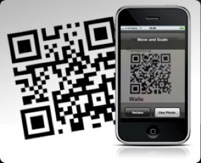Quick Response codes (QR codes) are going mainstream and creating quite the buzz. Similar to a barcode—QR codes are used by businesses to track inventory and price products at the point of sale; however, unlike one-dimensional barcodes, QR codes are two-dimensional and have the ability to hold more information, making them increasingly popular for retailers.
 A few weeks ago, I received a direct mail piece from Home Depot featuring a QR code. I immediately noticed it, whipped out my Blackberry and scanned away. I was directed to Home Depot’s mobile site, giving me access to product ratings, reviews, how-to guides and product-specific videos. The entire process was convenient, quick, and simply cool. According to Tom Sweeney, Senior Director of Online Strategy at HomeDepot.com, “The main objective…is to further enhance the customer shopping experience by offering additional product and project know-how and increase customer conversion.”
A few weeks ago, I received a direct mail piece from Home Depot featuring a QR code. I immediately noticed it, whipped out my Blackberry and scanned away. I was directed to Home Depot’s mobile site, giving me access to product ratings, reviews, how-to guides and product-specific videos. The entire process was convenient, quick, and simply cool. According to Tom Sweeney, Senior Director of Online Strategy at HomeDepot.com, “The main objective…is to further enhance the customer shopping experience by offering additional product and project know-how and increase customer conversion.”
A recent study called “The Naked Facts: Whiplash Edition” by Mobio Identity Systems, an international mobile payment and marketing company, shows an unbelievable 4549% increase in QR barcode scanning across the continent for the first 3 months of 2011. In terms of the type of media scanned, social media accounts for 70% of scans, TV 22%, offline four percent, online three percent, and print one percent. The report also highlights that Generation X and females continue to dominate the scanning world. And while some skeptics may think that consumers are just trying the QR code technology—the report points out that repeat scanners account for 62% of the market.
 QR codes also have the ability to become a powerful new method to reach target audiences with your public relations messaging and enhance communication strategies by offering more benefits. When executed correctly, consumers can see a QR code, scan it, and become instantly engaged in a brand’s message. Not only are QR codes a great way to understand the mobile audience, but they can be used in print media to connect a customer or prospect to additional content while offering a more interactive experience. It is apparent that this technology can be extremely powerful and an effective way to integrate media (print, web, multimedia) inside and outside a store for both consumers and businesses alike.
QR codes also have the ability to become a powerful new method to reach target audiences with your public relations messaging and enhance communication strategies by offering more benefits. When executed correctly, consumers can see a QR code, scan it, and become instantly engaged in a brand’s message. Not only are QR codes a great way to understand the mobile audience, but they can be used in print media to connect a customer or prospect to additional content while offering a more interactive experience. It is apparent that this technology can be extremely powerful and an effective way to integrate media (print, web, multimedia) inside and outside a store for both consumers and businesses alike.
 One company I came across that is taking QR scanning to the next level is the world’s leading e-commerce company, eBay. In December 2010, eBay announced the integration of Milo— a localized shopping search engine that catalogs and categorizes real-time inventory at more than 50,000 stores– into its free barcode scanning app RedLaser. According to Steve Yankovich, Vice President of Mobile at eBay,
One company I came across that is taking QR scanning to the next level is the world’s leading e-commerce company, eBay. In December 2010, eBay announced the integration of Milo— a localized shopping search engine that catalogs and categorizes real-time inventory at more than 50,000 stores– into its free barcode scanning app RedLaser. According to Steve Yankovich, Vice President of Mobile at eBay,  “By including Milo shopping results in the RedLaser iPhone and Android apps, we are providing access to real-time, accurate local inventory and the power of offline and online comparison-pricing. This provides our RedLaser users even more choice and flexibility when they come to us first to comparison shop.”
“By including Milo shopping results in the RedLaser iPhone and Android apps, we are providing access to real-time, accurate local inventory and the power of offline and online comparison-pricing. This provides our RedLaser users even more choice and flexibility when they come to us first to comparison shop.”
This integration proves eBay’s e-commerce prowess is unshakeable—as it has resulted in new opportunities for eBay to connect with buyers and sellers globally while creating a bridge between traditional and online retail. With over 9 million downloads, RedLaser has about 4,000 QR code scans per day. And this past month, RedLaser updated its app so that users can now create their own QR codes generated from contacts, URLs, or text.
Like most customers looking to save money and time, I am excited about the integration of Milo into RedLaser, and QR scanning. I like being in control of my shopping experience. It’s as if eBay, Milo, and RedLaser were all thinking about me when they integrated this app. While searching for a specific product, the results let me choose the best retailer for me based on price and location. I like that.
What do you think – are QR codes here to stay? Or are they overhyped marketing? When is the last time you scanned a QR code and what was was your experience like? If you haven’t tried them yet, why not? And if you’re a marketer, are you using them yet in your outreach strategies?
Please share your thoughts in the comments below.
 9 Questions: Tony Hsieh, Zappos
9 Questions: Tony Hsieh, Zappos


 A few weeks ago, I received a direct mail piece from Home Depot featuring a QR code. I immediately noticed it, whipped out my Blackberry and scanned away. I was directed to Home Depot’s mobile site, giving me access to product ratings, reviews, how-to guides and product-specific videos. The entire process was convenient, quick, and simply cool. According to Tom Sweeney, Senior Director of Online Strategy at
A few weeks ago, I received a direct mail piece from Home Depot featuring a QR code. I immediately noticed it, whipped out my Blackberry and scanned away. I was directed to Home Depot’s mobile site, giving me access to product ratings, reviews, how-to guides and product-specific videos. The entire process was convenient, quick, and simply cool. According to Tom Sweeney, Senior Director of Online Strategy at  QR codes also have the ability to become a powerful new method to reach target audiences with your public relations messaging and enhance communication strategies by offering more benefits. When executed correctly, consumers can see a QR code, scan it, and become instantly engaged in a brand’s message. Not only are QR codes a great way to understand the mobile audience, but they can be used in print media to connect a customer or prospect to additional content while offering a more interactive experience. It is apparent that this technology can be extremely powerful and an effective way to integrate media (print, web, multimedia) inside and outside a store for both consumers and businesses alike.
QR codes also have the ability to become a powerful new method to reach target audiences with your public relations messaging and enhance communication strategies by offering more benefits. When executed correctly, consumers can see a QR code, scan it, and become instantly engaged in a brand’s message. Not only are QR codes a great way to understand the mobile audience, but they can be used in print media to connect a customer or prospect to additional content while offering a more interactive experience. It is apparent that this technology can be extremely powerful and an effective way to integrate media (print, web, multimedia) inside and outside a store for both consumers and businesses alike. One company I came across that is taking QR scanning to the next level is the world’s leading e-commerce company,
One company I came across that is taking QR scanning to the next level is the world’s leading e-commerce company,  “By including Milo shopping results in the RedLaser iPhone and Android apps, we are providing access to real-time, accurate local inventory and the power of offline and online comparison-pricing. This provides our
“By including Milo shopping results in the RedLaser iPhone and Android apps, we are providing access to real-time, accurate local inventory and the power of offline and online comparison-pricing. This provides our 
 At least that is what I found out at my favorite SXSW session, “
At least that is what I found out at my favorite SXSW session, “